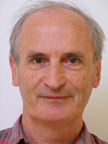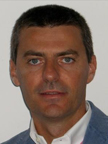 Advanced Multicarrier Waveforms.pdf
Advanced Multicarrier Waveforms.pdf
Tuesday, August 27
09:00 - 17:30
WS1: Advanced Multicarrier Waveforms and Mechanisms for Future Ad-Hoc and Cell-Based Systems (Invited talks)
 |
09:00 - 09:30
Invited talk: Filter Banks in Communications: Challenges and Perspectives
M. Bellanger, CNAM (Conservatoire National des Arts et Métiers), Paris-France |
|
| |
After the successful deployment of digital transmultiplexers at the interface of analogue and digital networks in the early eighties, one would have expected more applications of filter bank techniques in the communication systems to come. Instead, the multicarrier transmission concept has been implemented with OFDM in all the emerging applications: digital broadcasting, ADSL, PLC, local area wireless networks and cellular networks. Why communication equipment developers and network operators are so reluctant to use filter bank based techniques?
In the talk, three obstacles to the use of filter banks in communications are discussed, namely delay, equalization and complexity in both concept and computations. Two approaches, FBMC/OQAM and FMT/QAM, are compared and contrasted in that respect. To conclude, suggestions are offered to help get the support of standardization groups and gain acceptance by decision makers in industry and network operation.
|
|
| |
Biography:
Maurice Bellanger graduated from ENST (Ecole Nationale Supérieure des Télé-communications), Paris, in 1965 and received the doctorate degree from the university of Paris in 1981. He joined the company Philips Communications in France in 1967 and, since then, he has worked on digital signal processing and applications in telecommunications.
In 1991, he joined CNAM (Conservatoire National des Arts et Métiers), a public education and research institute, as a professor of electronics. He is now emeritus professor.
From 2008 to 2010, he was the coordinator of the European Research FP7-project “Physical Layer for Dynamic Spectrum Access and Cognitive Radio”-PHYDYAS (http://www.ict-phydyas.org/).
Elected a Fellow member of the IEEE in 1984, for contributions to the theory of digital filtering and the applications to communication systems, he was the technical program chairman of the conference ICASSP’82 in Paris. He was the president of EURASIP, the European Association for Signal Processing, from 1987 to 1994 and the chairman of the France section of URSI (Union Radio Scientifique Internationale) from 2006 to 2008. He is a member of the French Academy of Technology. |
|
|
|
|
 |
10:50 - 11:20
Invited talk: FBMC: An Idea Whose Time Has Come
P. Siohan, Orange Lab, Rennes-France
|
|
| |
In the famous paper: “Multicarrier modulation for data transmission: An idea whose time has come”, the author refers to conventional OFDM and also to multicarrier modulation based on offset (or staggered) QAM. Actually, in 1990 OFDM was already there with wireless (DAB) and wired (DSL) transmission systems and, since then, has known a tremendous success. At the contrary, all OFDM variants, today known as Filter Bank Multi-Carrier (FBMC) systems, are still marginal from a standardization and industrial point of view. However, with the OFDM/OQAM/IOTA proposal, the paper by Le Floch et al. in 1995 has renewed the interest for enhanced multicarrier systems. The talk will propose an overview of the impressive progresses that are being made since that time to get very competitive FBMC systems. Then, we will focus on some features of FBMC that still deserve a particular attention. Among those, are FBMC flexibility, packet transmission and efficient equalization.
|
|
| |
Biography:
Pierre Siohan (IEEE SM 1999) received the PhD degree from the École Nationale Supérieure des Télécommunications (ENST), Paris, France, in 1989. In 1977 he joined the Centre Commun d’Études de Télédiffusion et Télécommunications (CCETT), Rennes, where his activities were first concerned with the communication theory and its application to the design of broadcasting systems. Afterwards, he was in charge of the CCETT Mathematical and Signal Processing Group. From September 2001 to September 2003, he took a two-year sabbatical leave, being directeur de recherche with the Institut National de Recherche en Informatique et Automatique (INRIA), Rennes. Now, he his Expert in Networks and Telecom at Orange. His current research interests are in signal processing for communication, especially for radio and power line communication systems. Dr. Siohan has authored 31 papers in refereed international journals, 30 patents and 90 papers in international conferences. Recently, he was a guest editor of the special issue on “Filter Banks for Cognitive Next Generation Multicarrier Wireless Communications,” which appeared in EURASIP ASP journal. |
|
|
|
|
 |
13:40 - 14:10
Invited talk: What’s Next and Why on Filter Bank Modulation? From Concatenated FMT to Cyclic Block FMT
A. M. Tonello, University of Udine, Udine-Italy |
|
| |
Multicarrier modulation is enjoying great success in state-of-the-art physical layer wireless and wireline (e.g., power line communications) technologies. The most popular architecture is orthogonal frequency division multiplexing (OFDM). Aiming at increasing spectral efficiency, more general architectures based on filter bank modulation (FBM) have been proposed. This talk offers an overview of some recent advances and results about FBM trying to motivate the reasons why there is still space to devise interesting FBM digital architectures for application in multiple access asynchronous channels (both wireless and power line) affected by doubly dispersive fading and various non-idealities. In particular, focus will be given to Filtered Multitone Modulation (FMT) and novel schemes, namely, concatenated OFDM-FMT, MIMO Precoded FMT, Hybrid FMT, and Cyclic Block FMT. The application of such solutions is motivated by multiple ambitious objectives: the robustness not only to channel impairments but also to hardware limitations (FMT), the orthogonalization of the uplink channel (Concatenated FMT), the high capacity in MIMO frequency selective channels (Precoded FMT), the agile use of spectrum and the flexible adaptation of available resources (Hybrid FMT), the overall reduced latency/complexity and increased performance with simple orthogonal filter bank design (Cyclic Block FMT).
The main features of such schemes will be described and illustrative examples of performance will be given.
|
|
| |
Biography:
Andrea M. Tonello is an Aggregate Professor at the University of Udine, Italy (since 2003) where he leads the Wireless and Power Line Communication Lab. He is also the founder and president of WiTiKee, a university spin-off company. From 1997 to 2002 he has been with Bell Labs Lucent Technologies firstly as a Member of Technical Staff and then as a Technical Manager at the Advanced Wireless Technology Laboratory, Whippany, NJ and the Managing Director of the Bell Labs Italy division. He obtained the Laurea degree (1996) and the Doctor of Research degree in electronics and telecommunications (2003) from the University of Padova, Italy. Dr. Tonello received several recognitions among which the Lucent Bell Labs Recognition of Excellence award (1999) , the Distinguished Visiting Fellowship from the Royal Academy of Engineering, UK (2010) and the Distinguished Lecturer Award by the IEEE Vehicular Technology Society (2011-13 and 2013-15). He also received (as co-author) five best paper awards.
He is the Vice-chair of the IEEE Communications Society Technical Committee on Power Line Communications. He serves/ed as an Associate Editor for the IEEE Transactions on Vehicular Technology (2007-2013), for the IEEE Transactions on Communications (2012-TD) and IEEE Access (2013-TD). Web site: www.diegm.uniud.it/tonello
|
|
Workshop Chairs
Faouzi Bader, CTTC, Barcelona, Spain (SUPELEC, France from June)
Markku Renfors, Tampere University of Technology (TUT), Finland
Didier le Ruyet, Conservatoire National des Arts et Métiers (CNAM), Paris-France
Philippe Mège, CASSIDIAN, Paris, France
Technical Program Committee
Tor André Myrvoll, SINTEF, Norway
Cipriano Antonio, THALES Communications and Security, France
Kareem Baddour, CRC, Canada
Philippe Ciblat, Telecom-ParisTech, France
Maria Julia Fernandez-Getino, Universidad Carlos III, Spain
Leonardo Gomes Baltar, Technical University of Munich, Germany
Martin Haardt, Ilmenau University of Technology, Germany
Tobias Hidalgo Stitz, Magister, Finland
Eleftherios Kofidis, University of Piraeus, Greece
Rodrigo de Lamare, University of York, UK
Marie Laure Boucheret, ENSEEIHT, Toulouse, France
Martinod, Laurent, CASSIDIAN, Paris, France
Jerome Louveaux, Université Catholique de Louvain, Belgium
Xavier Mestre, CTTC, Spain
Slobodan Nedic, University of Novi Sade, Serbia
Hang Nguyen, Telecom Sudparis, France
Montse Najár, Universitat Politècnica de Catalunya (UPC), Spain
Josef Nossek, Technical University of Munich, Germany
Nikos Passas, University of Athens (UoA), Greece
Ana Pérez Neira, Universitat Politècnica de Catalunya (UPC), Spain
Mylène Pischella, CNAM, Paris, France
Vidar Ringset, SINTEF, Norway
Tapani Ristaniemi, MAGISTER SL, Finland
Daniel Roviras, CNAM, France
Theodoridis Sergios, University of Athens (UoA), Greece.
Cyrille Siclet, Institut National Polytechnique de Grenoble, France
Pierre Siohan, Orange, France
Luc Vandendorpe, Université Catholique de Louvain, Belgium
Santiago Zazo, Universidad Politécnica de Madrid, Spain
Hanna Bogucka, Poznan University of Technology (PUT), Poland
Mario Tanda, UNINA, University of Naples Federico II. Itatly
Yahia Medjahdi, CNAM, Paris, France
Adrian Kliks, Poznan University of Technology (PUT), Poland